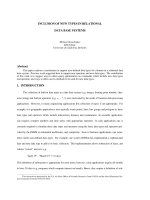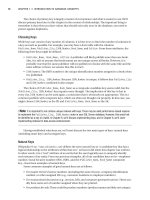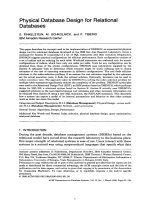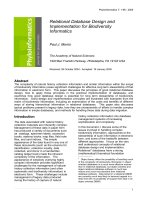Relational Database Design
Bạn đang xem bản rút gọn của tài liệu. Xem và tải ngay bản đầy đủ của tài liệu tại đây (880.72 KB, 32 trang )
Relational Database Design by
ER- and EERR-to-Relational
Mapping
Chapter Outline
ER-to-Relational Mapping Algorithm
Step 1: Mapping of Regular Entity Types
Step 2: Mapping of Weak Entity Types
Step 3: Mapping of Binary 1:1 Relation Types
Step 4: Mapping of Binary 1:N Relationship Types.
Step 5: Mapping of Binary M:N Relationship Types.
Step 6: Mapping of Multivalued attributes.
Step 7: Mapping of N-ary Relationship Types.
Mapping EER Model Constructs to Relations
Step 8: Options for Mapping Specialization or Generalization.
Step 9: Mapping of Union Types (Categories).
ER-to-Relational Mapping
Algorithm
Step 1: Mapping of Regular Entity Types.
–
For each regular (strong) entity type E in the ER schema, create a
relation R that includes all the simple attributes of E.
–
Choose one of the key attributes of E as the primary key for R. If the
chosen key of E is composite, the set of simple attributes that form it
will together form the primary key of R.
Example: We create the relations EMPLOYEE, DEPARTMENT, and
PROJECT in the relational schema corresponding to the regular entities
in the ER diagram. SSN, DNUMBER, and PNUMBER are the primary
keys for the relations EMPLOYEE, DEPARTMENT, and PROJECT as
shown.
FIGURE 7.1
The ER
conceptual
schema
diagram for
the
COMPANY
database.
FIGURE 7.2
Result of
mapping the
COMPANY
ER schema
into a
relational
schema.
ER-to-Relational Mapping
Algorithm (cont)
Step 2: Mapping of Weak Entity Types
–
For each weak entity type W in the ER schema with owner entity type E,
create a relation R and include all simple attributes (or simple components of
composite attributes) of W as attributes of R.
–
In addition, include as foreign key attributes of R the primary key attribute(s)
of the relation(s) that correspond to the owner entity type(s).
–
The primary key of R is the combination of the primary key(s) of the owner(s)
and the partial key of the weak entity type W, if any.
Example: Create the relation DEPENDENT in this step to correspond to the
weak entity type DEPENDENT. Include the primary key SSN of the
EMPLOYEE relation as a foreign key attribute of DEPENDENT (renamed to
ESSN).
The primary key of the DEPENDENT relation is the combination {ESSN,
DEPENDENT_NAME} because DEPENDENT_NAME is the partial key of
DEPENDENT.
ER-to-Relational Mapping
Algorithm (cont)
Step 3: Mapping of Binary 1:1 Relation Types
For each binary 1:1 relationship type R in the ER schema, identify
the relations S and T that correspond to the entity types
participating in R. There are three possible approaches:
(1) Foreign Key approach: Choose one of the relations-S, say-and include a foreign
key in S the primary key of T. It is better to choose an entity type with total
participation in R in the role of S.
Example: 1:1 relation MANAGES is mapped by choosing the participating entity type
DEPARTMENT to serve in the role of S, because its participation in the MANAGES
relationship type is total.
(2) Merged relation option: An alternate mapping of a 1:1 relationship type is
possible by merging the two entity types and the relationship into a single relation.
This may be appropriate when both participations are total.
(3) Cross-reference or relationship relation option: The third alternative is to set up a
third relation R for the purpose of cross-referencing the primary keys of the two
relations S and T representing the entity types.
ER-to-Relational Mapping
Algorithm (cont)
Step 4: Mapping of Binary 1:N Relationship Types.
–
For each regular binary 1:N relationship type R, identify the relation S
that represent the participating entity type at the N-side of the
relationship type.
–
Include as foreign key in S the primary key of the relation T that
represents the other entity type participating in R.
–
Include any simple attributes of the 1:N relation type as attributes of S.
Example: 1:N relationship types WORKS_FOR, CONTROLS, and
SUPERVISION in the figure. For WORKS_FOR we include the
primary key DNUMBER of the DEPARTMENT relation as foreign
key in the EMPLOYEE relation and call it DNO.
ER-to-Relational Mapping
Algorithm (cont)
Step 5: Mapping of Binary M:N Relationship Types.
–
For each regular binary M:N relationship type R, create a new relation S
to represent R.
–
Include as foreign key attributes in S the primary keys of the relations that
represent the participating entity types; their combination will form the
primary key of S.
–
Also include any simple attributes of the M:N relationship type (or simple
components of composite attributes) as attributes of S.
Example: The M:N relationship type WORKS_ON from the ER diagram
is mapped by creating a relation WORKS_ON in the relational database
schema. The primary keys of the PROJECT and EMPLOYEE relations are
included as foreign keys in WORKS_ON and renamed PNO and ESSN,
respectively.
Attribute HOURS in WORKS_ON represents the HOURS attribute of the
relation type. The primary key of the WORKS_ON relation is the
combination of the foreign key attributes {ESSN, PNO}.
ER-to-Relational Mapping
Algorithm (cont)
Step 6: Mapping of Multivalued attributes.
–
For each multivalued attribute A, create a new relation R. This relation R
will include an attribute corresponding to A, plus the primary key attribute
K-as a foreign key in R-of the relation that represents the entity type of
relationship type that has A as an attribute.
–
The primary key of R is the combination of A and K. If the multivalued
attribute is composite, we include its simple components.
Example: The relation DEPT_LOCATIONS is created. The attribute
DLOCATION represents the multivalued attribute LOCATIONS of
DEPARTMENT, while DNUMBER-as foreign key-represents the
primary key of the DEPARTMENT relation. The primary key of R is the
combination of {DNUMBER, DLOCATION}.
ER-to-Relational Mapping
Algorithm (cont)
Step 7: Mapping of N-ary Relationship Types.
–
For each n-ary relationship type R, where n>2, create a new
relationship S to represent R.
–
Include as foreign key attributes in S the primary keys of the
relations that represent the participating entity types.
–
Also include any simple attributes of the n-ary relationship
type (or simple components of composite attributes) as
attributes of S.
Example: The relationship type SUPPY in the ER below. This can be
mapped to the relation SUPPLY shown in the relational schema, whose
primary key is the combination of the three foreign keys {SNAME,
PARTNO, PROJNAME}
FIGURE 4.11
Ternary relationship types. (a) The SUPPLY relationship.
FIGURE 7.3
Mapping the n-ary relationship type SUPPLY from
Figure 4.11a.
Summary of Mapping constructs
and constraints
Table 7.1 Correspondence between ER and Relational Models
ER Model Relational Model
Entity type “Entity” relation
1:1 or 1:N relationship type Foreign key (or “relationship” relation)
M:N relationship type “Relationship” relation and two foreign keys
n-ary relationship type “Relationship” relation and n foreign keys
Simple attribute Attribute
Composite attribute Set of simple component attributes
Multivalued attribute Relation and foreign key
Value set Domain
Key attribute Primary (or secondary) key
Mapping EER Model Constructs to
Relations
Step8: Options for Mapping Specialization or Generalization.
Convert each specialization with m subclasses {S
1
, S
2
,….,S
m
} and
generalized superclass C, where the attributes of C are {k,a
1
,…a
n
}
and k is the (primary) key, into relational schemas using one of
the four following options:
Option 8A: Multiple relations-Superclass and subclasses.
Create a relation L for C with attributes Attrs(L) = {k,a
1
,…a
n
} and PK(L) =
k. Create a relation L
i
for each subclass S
i
, 1 < i < m, with the
attributesAttrs(L
i
) = {k} U {attributes of S
i
} and PK(L
i
)=k. This option
works for any specialization (total or partial, disjoint of over-lapping).
Option 8B: Multiple relations-Subclass relations only
Create a relation L
i
for each subclass S
i
, 1 < i < m, with the attributes
Attr(L
i
) = {attributes of S
i
} U {k,a
1
…,a
n
} and PK(L
i
) = k. This option only
works for a specialization whose subclasses are total (every entity in the
superclass must belong to (at least) one of the subclasses).
FIGURE 4.4
EER diagram
notation for an
attribute-
defined
specialization
on JobType.
FIGURE 7.4
Options for mapping specialization or generalization.
(a) Mapping the EER schema in Figure 4.4 using option
8A.
FIGURE 4.3
Generalization. (b) Generalizing CAR and TRUCK into the
superclass VEHICLE.
FIGURE 7.4
Options for mapping specialization or generalization.
(b) Mapping the EER schema in Figure 4.3b using
option 8B.
Mapping EER Model Constructs to
Relations (cont)
Option 8C: Single relation with one type attribute.
Create a single relation L with attributes Attrs(L) = {k,a
1
,…a
n
} U
{attributes of S
1
} U…U {attributes of S
m
} U {t} and PK(L) = k. The
attribute t is called a type (or discriminating) attribute that
indicates the subclass to which each tuple belongs
Option 8D: Single relation with multiple type attributes.
Create a single relation schema L with attributes Attrs(L) = {k,a
1
,
…a
n
} U {attributes of S
1
} U…U {attributes of S
m
} U {t
1
, t
2
,…,t
m
} and
PK(L) = k. Each t
i
, 1 < I < m, is a Boolean type attribute indicating
whether a tuple belongs to the subclass S
i
.
FIGURE 4.4
EER diagram
notation for an
attribute-
defined
specialization
on JobType.
FIGURE 7.4
Options for mapping specialization or generalization.
(c) Mapping the EER schema in Figure 4.4 using option
8C.
FIGURE 4.5
EER diagram notation for an overlapping (nondisjoint)
specialization.
FIGURE 7.4
Options for mapping specialization or generalization.
(d) Mapping Figure 4.5 using option 8D with Boolean
type fields Mflag and Pflag.
Mapping EER Model Constructs to
Relations (cont)
Mapping of Shared Subclasses (Multiple Inheritance)
A shared subclass, such as STUDENT_ASSISTANT, is a subclass of
several classes, indicating multiple inheritance. These classes must
all have the same key attribute; otherwise, the shared subclass
would be modeled as a category.
We can apply any of the options discussed in Step 8 to a shared
subclass, subject to the restriction discussed in Step 8 of the
mapping algorithm. Below both 8C and 8D are used for the shared
class STUDENT_ASSISTANT.









